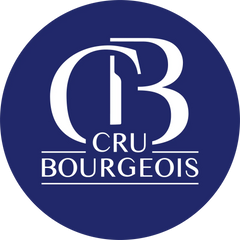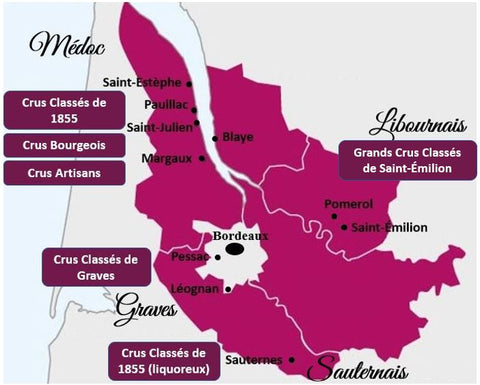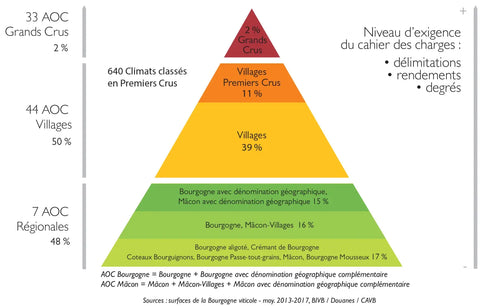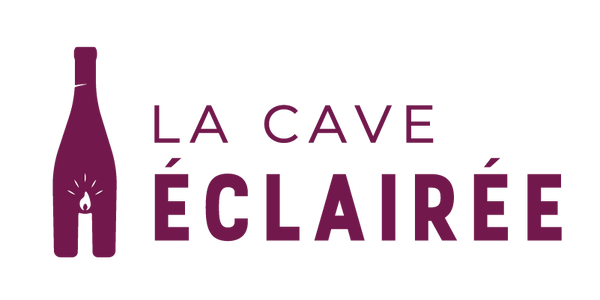By the end of your reading, you will be able to better understand these classifications, their histories, and assess their real interests and values. In this first part, we will focus solely on the two iconic wine regions of our beautiful country: Burgundy and Bordeaux ! If you wish to view the continuation, go directly to the rankings of other wine regions. There you will discover the hierarchies used within the regions of Alsace, Champagne, Loire, and even Provence.
The Bordeaux rankings
Numerous rankings involving the notion of Cru exist within the Bordeaux region, leaving the novice consumer somewhat confused.Nevertheless, a common point unites these hierarchies: they all reward properties without exception and not precisely delineated plots.
Here is an overview of the 5 classifications to remember ranking the 118 000 hectares of AOC vineyards in the region.
The 1855 classification
It is the most renowned of all, the one that makes the great names of the region resonate in our ears : Château Margaux, Château Latour, Château Lafite, Château Haut-Brion etc.As its name suggests, its creation dates back to the year 1855 and was made possible by Napoleon III, who then asked each French wine region to establish a ranking of their best wines for the Universal Exhibition of the same year.
In response to this request, the Bordelais created a ranking in 5 levels for the reds of Médoc (1st Grand Cru Classé, 2nd Grand Cru Classé, 3rd Grand Cru Classé etc.) and in 3 levels for the sweet whites of Sauternais (Premier Cru Supérieur, Premier Cru, Deuxième Cru) according to the sole criteria of notoriety and price of the time.This classification today includes a total of 88 châteaux (61 for reds and 27 from the Sauternes region), all more prestigious than the others.
Nevertheless, this ranking has been criticized for several decades now.Indeed, what value can still be attributed to it knowing that it has (almost) never evolved since its creation and is considered immutable ?!
Today, it is clear that while the 1st Grands Crus and a good portion of the Seconds suffer almost no dispute regarding their superiority, the hierarchy of the lower levels would probably be subject to significant changes if it were to be updated! Thus, for example, the Château Pontet-Canet (Pauillac), currently ranked at the 5th and last level, would likely be propelled 2 to 3 levels higher while other properties might be brought down one or two levels, or even removed from this ranking.Similarly, some currently unclassified estates would probably deserve to be included.
Thus, it will be preferable to seek advice if you wish to choose a prestigious bottle from one of these properties, especially if the estate is ranked in the 3rd tier of the classification or below.You can also check the Grands Crus Bordelais available at La Cave Éclairée to make your choice with confidence!

The classification of Graves wines
The prestigious 1855 classification did not take into account the properties of the Graves region (south of Bordeaux), a dedicated hierarchy for this area was created in 1953, then completed in 1959, distinguishing without ranking 16 estates, all located in the Pessac-Léognan area (the AOC did not yet exist in the 1950s).
Some châteaux are awarded solely for their red wine, others only for their white, and some for both. Among this ranking, a few famous names like Château Smith-Haut-Lafite or Château Carbonnieux.
This hierarchy, although more recent, is also immutable. The same issues arise as with the 1855 classification.

The Grands Crus of Saint-Émilion
The AOC Saint-Emilion is vast : 5,400 hectares. To classify this large ensemble, a classification was created in 1954 with a distribution into 3 levels. This hierarchy is still relevant today but it is nevertheless evolving compared to previous fixed classifications.
Thus, in 2022, the latest Saint-Émilion ranking recognized 2 châteaux at the top of the hierarchy as "Premier Grand Cru Classé A": Château Figeac and Château Pavie . Then, 12 other properties were classified as "Premier Grand Cru Classé" and finally 71 vineyards as "Grand Cru Classé". Let's admit that our Bordeaux friends could have chosen a different rating scale to avoid semantic confusion with other rankings, but let's move on...
As mentioned, and unlike neighboring rankings, the Saint-Émilion classification is updated every decade . The next classification will therefore take place in 2032 after the one in 2022.If this update seems fairer from the amateur's point of view, it nevertheless results in numerous imbroglios. For a very recent example, the Châteaux Cheval Blanc and Ausone (at the top of the previous 2012 classification) did not wish to participate in the 2022 ranking because the evaluation criteria, in their view, strayed too far from aspects of terroir, quality, and history in favor of secondary elements.This is a stain !
If the scalability of this ranking allows (in my opinion) for greater equity among properties while remaining a reliable indicator over time for consumers, this same scalability is at the same time a source of numerous frictions within the appellation, leading to deteriorate the general image of this hierarchy as well as its credibility.
PS : it is important to not confuse the mention “ Grand Cru Classé ” (referring to the ranking) with the mention “ Saint-Émilion Grand Cru ” (yet another semantic issue) that you might find on certain bottles.Indeed, this simply means that the wine produced comes from the AOC Saint-Émilion Grand Cru, covering exactly the same production area as the simple AOC Saint-Émilion ! The only differences : slightly stricter production conditions (lower yields, minimum aging of 12 months, etc.).Once again, one might feel that everything is done to mislead the consumer !

Les Crus Bourgeois
The history of Crus Bourgeois dates back to the 12th century. However, in the modern sense of the term, the mention "Cru Bourgeois" has only been recognized since 1978.Since that date, it has been officially used to highlight the properties of Médoc that were not included in the grand classification of 1855. The first classification of Crus Bourgeois took place in 2003. Recurrent legal imbroglios also exist around this label given the economic stakes. Thus, this first classification of 2003 was challenged and then annulled in 2007. Then, after several years of reorganization, it was decided that the mention "Cru Bourgeois" would be reassigned every 5 years to give the properties greater commercial flexibility (the hierarchy previously evolved each year).
This classification is divided into 3 levels :
-Cru Bourgeois Exceptionnel (14 properties),
-Cru Bourgeois Supérieur (56),
-Cru Bourgeois (179).
It should be noted that the 249 recognized estates in this hierarchy must necessarily come from the 8 Médoc AOCs (Médoc, Haut-Médoc, Saint-Estèphe, Listrac-Médoc, Moulis-en-Médoc, Margaux, Pauillac, and Saint-Julien).
As you might expect, it is complex to achieve a consistent level of quality with such a large number of domains accounting for about 30% of Médoc production ! However, the selection criteria are well-defined : all wines are tasted blind over 5 vintages, and other factors such as environmental practices or overall management of the estate are also considered.
Nevertheless, some renowned properties still shun this classification and never present their wine, having more to lose than to gain. Additionally, since some Crus Bourgeois can be found in large retail chains at relatively low price levels, the renowned vineyards absolutely do not want to be associated with this "low cost" image.
In summary, this ranking, enjoying a good reputation, is a good indicator of quality but mainly for the first two levels (Exceptional and Superior). The simple mention of " Cru Bourgeois " can bring together fine wines with interesting quality-price ratios alongside other cuvées of little interest. A good knowledge of the estates and vintages will then become essential to make the right choices.
La Cave Éclairée for example, recommends the excellent Cru Bourgeois Supérieur from Château Saransot-Dupré.

Les Crus Artisans
The designation « Cru Artisan » was created in 1989 to highlight the small and medium-sized properties of the Médoc where the estate manager carries out all the stages of wine production on the estate (own management of the vineyard and vinification, aging, and bottling).
36 properties currently benefit from this mention which does not guarantee the quality of the wines in any way and was solely created to highlight small producers in the region neglected by other classifications. The Crus Artisans classification is reviewed every 5 years.

Burgundy: Grands and Premiers Crus
Burgundy is certainly the region where the notion of Cru is the most recognized of all.If this is partly due to the admiration many of us have for its wines, it is also probably related to its 2,000 years of winemaking history as well as the great precision of the established hierarchy. The modern history of the classification of Burgundy's crus begins at the end of the 15th century, when the notion of "Climat" appears. A climat is a precisely defined plot of vines with specific geological and climatic characteristics. Then, in 1855, under the impetus of Napoleon III (again!), work was undertaken by Jules Lavalle, a naturalist and botanist, to classify the Burgundy terroirs.This classification will serve as the basis for the INAO (National Institute of Appellations of Origin) during the creation in 1935 of the AOCs of Burgundy.
Today, thanks to these studies, more than 1000 Climats are now mapped, including 33 Grands Crus as well as 640 Premiers Crus. These are so precious that they have been listed since 2015 as a UNESCO World Heritage site and a museum located in Beaune is entirely dedicated to them !
Of the 30 000 hectares of vineyards in the region, only 600 bear the Grand Cru designation (2%) and 3300 the Premier Cru designation (11%). It is therefore a precise selection of the best plots allowing the production of the very best wines in the world (and the most expensive...). Of course, the work of the winemaker is, as always, decisive in the quality of the wines obtained, and some bottles labeled "Premier Cru" may be on par with "Grand Cru" bottles, just as some "Premier Cru" vintages may be disappointing compared to certain wines from a Village AOC like Pommard or Gevrey-Chambertin. Nevertheless, this classification currently represents the best in the wine world, and many foreign countries are inspired by it.
If you wish to discover some of these wines, feel free to take a look at the Grand Crus and Premier Crus from Burgundy carefully selected and available at La Cave Éclairée.

Conclusion
As you may have understood from this reading, the notion of Cru therefore has a different meaning depending on the region where one is located : while in Bordeaux, it primarily highlights the estate as a whole, through its viticultural history and historical reputation, in Burgundy, it is primarily linked to the land and emphasizes plots known for producing the best wines.
Hoping that you are now unbeatable on the subject ! In the next article, you will discover the wine rankings of other French regions (Alsace, Champagne, Loire, Provence).
See you soon at La Cave Éclairée!



















